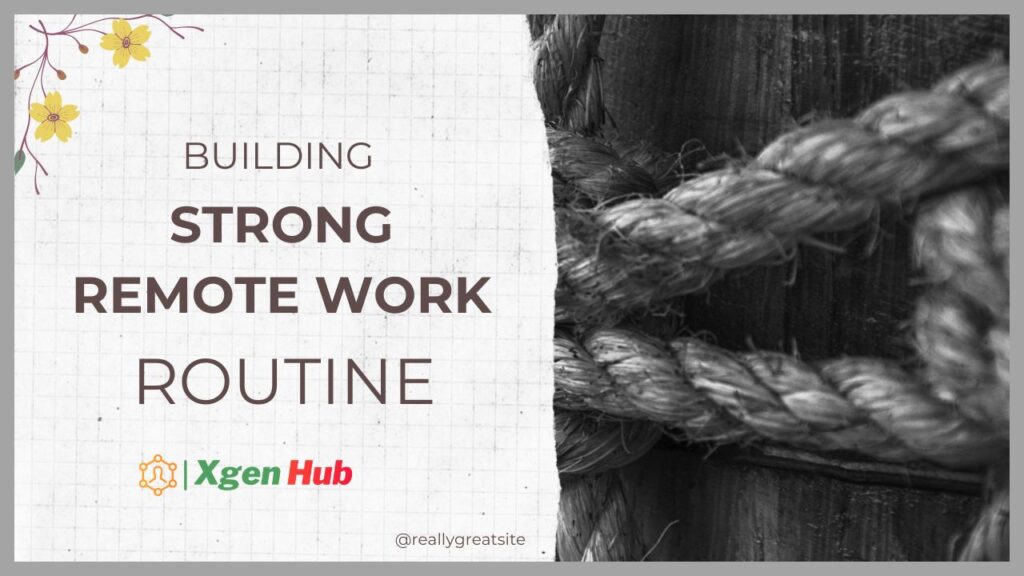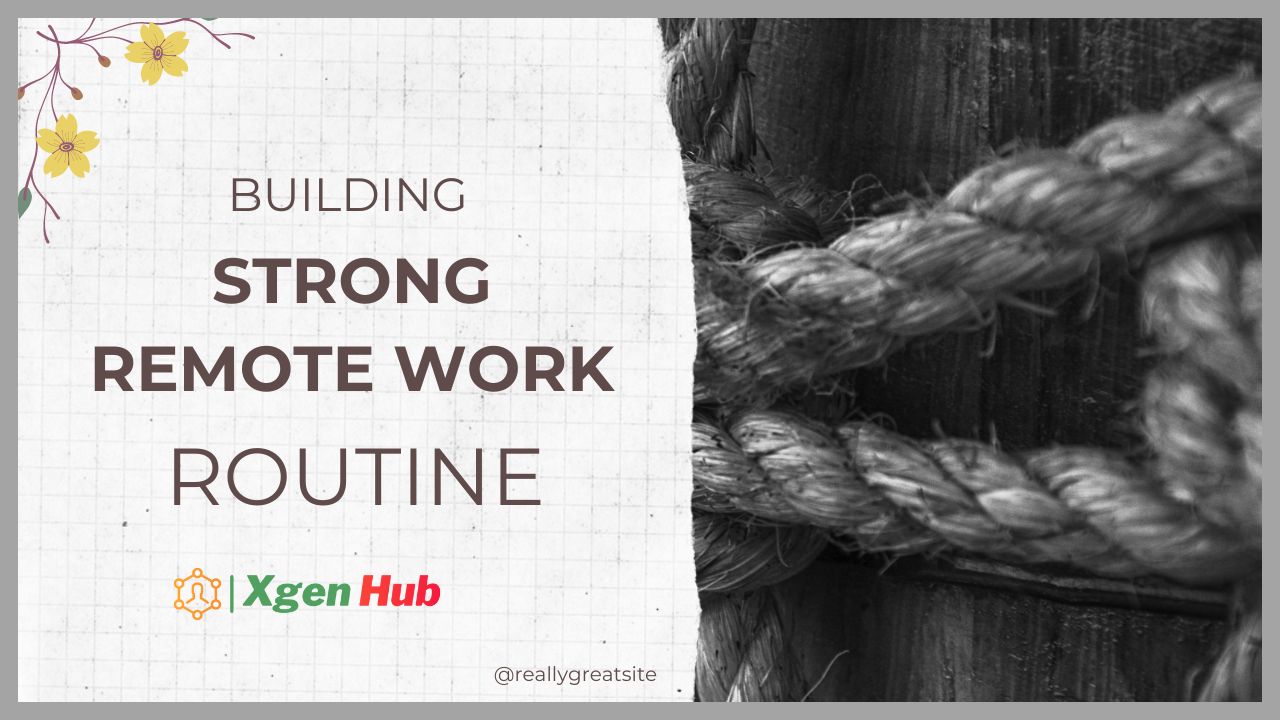Hey I’m Inzamul, Welcome to my article today I am going to breakdown Building a Strong Remote Work Routine
In recent years, the landscape of work has undergone a significant transformation with the widespread adoption of remote work. What was once considered a perk for a select few has now become a norm for many industries. Remote work, also known as telecommuting or working from home, refers to the practice of performing one’s job duties outside of a traditional office setting, often using digital technology to stay connected with colleagues and clients.
Check Out My NO-1 Proven Method to Earn $100-$500/Day with FREE Traffic

The rise of remote work can be attributed to various factors, including advancements in technology, changing attitudes towards work-life balance, and the global shift towards a knowledge-based economy. While remote work offers undeniable benefits such as increased flexibility and autonomy, it also presents unique challenges that must be addressed to ensure success.
Understanding the Importance of a Strong Remote Work Routine
One of the key factors that contribute to the success of remote work is the establishment of a strong routine. Unlike traditional office environments where the structure is often dictated by set working hours and physical presence, remote work requires individuals to proactively manage their time and tasks.
Check Out My NO-1 Proven Method to Earn $100-$500/Day with FREE Traffic
A strong remote work routine serves as a framework for productivity and well-being. It provides structure and predictability, helping individuals stay focused and organized amidst the distractions of home life. Moreover, a well-defined routine can help mitigate the blurred boundaries between work and personal life that are often inherent in remote work situations.
Key Components of a Strong Remote Work Routine
Building a strong remote work routine involves several key components:
Setting Boundaries and Expectations
Establishing clear boundaries between work and personal life is crucial for maintaining balance and preventing burnout. This includes defining working hours, communicating availability to colleagues and family members, and creating physical barriers within the home environment if possible.
Establishing a Dedicated Workspace
Having a designated area for work can help signal to the brain that it’s time to focus and be productive. Ideally, this space should be free from distractions and equipped with all the necessary tools and resources to facilitate work.
Planning and Scheduling Tasks Effectively
Effective time management is essential for remote workers to juggle multiple responsibilities and deadlines. This involves creating daily or weekly schedules, prioritizing tasks based on importance and urgency, and allocating specific time slots for focused work, collaboration, and breaks.
Prioritizing Self-Care and Breaks
Taking regular breaks and prioritizing self-care activities is essential for maintaining overall well-being and preventing burnout. Remote workers should incorporate short breaks throughout the day to rest and recharge, as well as schedule time for exercise, mindfulness, and other activities that promote mental and physical health.
Tips for Building and Maintaining a Successful Remote Work Routine
Building a successful remote work routine requires intentionality and adaptability. Here are some tips to help you establish and maintain a routine that works for you:
Check Out My NO-1 Proven Method to Earn $100-$500/Day with FREE Traffic
Creating a Morning Routine
Start your day on the right foot by establishing a morning routine that sets a positive tone for the rest of the day. This could include activities such as meditation, exercise, journaling, or enjoying a nutritious breakfast.
Time-Blocking Techniques
Use time-blocking techniques to allocate specific time slots for different tasks and activities throughout the day. This can help you stay focused and avoid the trap of multitasking, allowing you to devote your full attention to each task.
Leveraging Technology and Tools
Take advantage of technology and productivity tools to streamline your workflow and stay organized. Whether it’s project management software, communication apps, or time-tracking tools, find the tools that work best for you and incorporate them into your routine.
Incorporating Flexibility While Maintaining Structure
While routine is important, it’s also essential to remain flexible and adaptable to changing circumstances. Embrace the unexpected and be willing to adjust your routine as needed to accommodate new priorities, challenges, and opportunities.
Addressing Common Challenges in Remote Work Routines
Despite its many benefits, remote work also presents its fair share of challenges. Here are some common challenges that remote workers may encounter, along with strategies for addressing them:
Overcoming Isolation and Loneliness
Working remotely can sometimes feel isolating, especially for individuals who thrive on social interaction. To combat feelings of loneliness, make an effort to stay connected with colleagues through virtual meetings, chat channels, and social events. Additionally, consider joining online communities or networking groups for remote workers to foster connections and support.
Managing Distractions and Staying Focused
Working from home can expose remote workers to a myriad of distractions, from household chores to social media. To stay focused, create a distraction-free work environment, set boundaries with family members or roommates, and use productivity techniques such as the Pomodoro method to maintain concentration.
Balancing Work and Personal Life Boundaries
One of the biggest challenges of remote work is the potential for work to encroach on personal time and vice versa. To maintain a healthy balance, establish clear boundaries between work and personal life, set realistic expectations with colleagues and clients, and prioritize self-care and leisure activities outside of work hours.
The Role of Communication in Remote Work Routines
Effective communication is the cornerstone of successful remote work. Without the benefit of face-to-face interaction, remote teams must rely on digital communication tools to collaborate, coordinate, and stay connected.
Check Out My NO-1 Proven Method to Earn $100-$500/Day with FREE Traffic
Adapting and Evolving Your Remote Work Routine
Building a strong remote work routine is not a one-size-fits-all endeavor. It requires ongoing experimentation, reflection, and adaptation to find what works best for you. Be open to trying new strategies, learning from both successes and failures, and making adjustments as needed to optimize your productivity and well-being.
Conclusion
In conclusion, building a strong remote work routine is essential for success in today’s increasingly remote-friendly work environment. By establishing clear boundaries, prioritizing self-care, and leveraging technology effectively, remote workers can create a routine that promotes productivity, creativity, and overall well-being.
Unique FAQs
1. How can I stay motivated while working remotely?
- Staying motivated while working remotely can be challenging, but it’s essential to find what inspires and energizes you. Set goals, create a supportive environment, and celebrate your achievements along the way.
2. What are some strategies for overcoming procrastination when working from home?
- To overcome procrastination, break tasks down into smaller, manageable steps, eliminate distractions, and hold yourself accountable with deadlines and rewards.
3. How can I maintain work-life balance while working remotely?
- Maintaining work-life balance requires setting boundaries, prioritizing self-care, and scheduling regular breaks and leisure activities outside of work hours.
4. What should I do if I feel overwhelmed by my workload while working remotely?
- If you’re feeling overwhelmed, prioritize tasks based on urgency and importance, delegate when possible, and don’t hesitate to seek support from colleagues or supervisors.
5. How can I combat feelings of isolation and loneliness while working remotely?
- Combat feelings of isolation by staying connected with colleagues through virtual meetings and chat channels, joining online communities for remote workers, and scheduling regular social interactions outside of work.
Check Out My NO-1 Proven Method to Earn $100-$500/Day with FREE Traffic
Outline of the Article
- Introduction to Remote Work
- What is remote work?
- Rise of remote work culture.
- Benefits and challenges.
- Understanding the Importance of a Strong Remote Work Routine
- Why is a routine essential for remote work?
- Impact on productivity and well-being.
- Overcoming common pitfalls without a routine.
- Key Components of a Strong Remote Work Routine
- Setting boundaries and expectations.
- Establishing a dedicated workspace.
- Planning and scheduling tasks effectively.
- Prioritizing self-care and breaks.
- Tips for Building and Maintaining a Successful Remote Work Routine
- Creating a morning routine.
- Time-blocking techniques.
- Leveraging technology and tools.
- Incorporating flexibility while maintaining structure.
- Addressing Common Challenges in Remote Work Routines
- Overcoming isolation and loneliness.
- Managing distractions and staying focused.
- Balancing work and personal life boundaries.
- The Role of Communication in Remote Work Routines
- Importance of clear communication.
- Utilizing various communication channels.
- Establishing regular check-ins and feedback loops.
- Adapting and Evolving Your Remote Work Routine
- Recognizing when adjustments are needed.
- Experimenting with different strategies.
- Learning from setbacks and successes.
- Conclusion
- Recap of the importance of a strong remote work routine.
- Encouragement to implement and adapt routines for sustained success.
Thanks for read my article, Building a Strong Remote Work Routine
